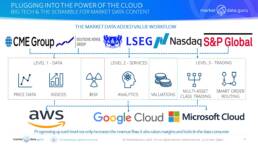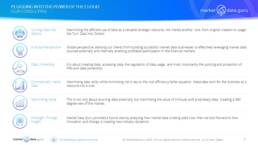
WHY IS BIG TECH SO INTERESTED IN MARKET DATA?
The amount of money generated in market data service is not only high margin, it is incredibly ‘sticky’ thereby delivering long term revenue flows. Combine these attributes with the ability to tie in major exchange groups offering global multi-asset class capabilities must be attractive to Cloud Providers determined to maximise their investment in infrastructure and delivery. In other words, the Cloud providers need content with value added services, like analytics, and in future trading functionality to feed their financial institution clientele, with the ability to expand into the vast and underserved retail investor market.
Why Now?
Simply put until recently the big exchanges could not offer anything more than straight price data. What has changed is the large global exchange groups now possess a wider range of products thanks to a spending spree focused on buying up analytics, services, and solutions providers. This means the likes of Deutsche Börse Group, LSEG, and NASDAQ along with original data source owner S&P Global can now supply from one source a range of products, now with processing capabilities. Even if the clients do not want the exchange’s own data, they can still subscribe to their services utilising other sources.
We see the relationships between Big Tech and Financial Information engaging in a three stage process, of which stage 1 has been achieved, but stages 2 and 3 offer ever greater value added revenues and profits. These are:
1.Offering data (already there)
2.Provide higher margin analytics and services (in progress)
3.Create high tech trading venues (the holy grail)
For smaller exchanges, vendors, and independent third party solution providers it dramatically alters competitive dynamics, and for data consumers offers what may prove to be superficially attractive options to reduce costs in the short term.

TRADITIONAL VENDORS & SMALLER EXCHANGES MUST BE WORRIED
If was a Bloomberg I would be concerned, less so for Refinitiv as they are part of LSEG. While the Cloud Providers are delivering a vendor like service there is a serious difference where those words ‘analytics’, ‘services’ and ‘scalability’ resurface.
The traditional vendors deliver an exchanges’ price data to data consumers via their networks and their clients can use the vendors own services, or a third party, to process that price data. Bloomberg provides an excellent example of this, as well as offering trading connectivity across a range of markets within their own platform additionally. But the exchanges proprietary services are not part of the arrangement.
With the Cloud providers tie ups, the value added services and analytics are the keys to each deal, with price data becoming a part of the bundle of offerings that can be made available directly to the data consumer. These Cloud Providers become ‘Market Data Vendors Plus’.
This gives the opportunity for the exchanges combined with the high power infrastructure of Big Tech to become both providers and processors of the data. A beguiling inducement for smaller financial institutions lacking resources looking for cost effective one stop data solutions, even if the deals on offer lock them into long term contracts that could prove very difficult to unravel.
In this scenario, smaller exchanges entering their own agreements with Cloud Providers end up becoming content fodder, merely feeding their own price data into larger brethren’s solutions even for their own local markets. More worrying, as the larger exchanges offer more trading on their own platforms with their Cloud partners they can create de facto dark pools syphoning off trading from other markets.
IMPACTS AND IMPLICATIONS
What do the deals between Big Tech and Big Exchanges mean to both the competition and the data consumer?
Longer term if the regulators have any potential competition issues it will be too late, because flags are not being raised now. The trigger is likely when the deals start to drive trading into these Clouds. Already that is a goal of the AWS/NASDAQ agreement. Why? Because it will enable the global exchanges to offer trading backed by data products and services to every corner of the world by eliminating existing barriers to entry. A Bursa Malaysia or Warsaw Stock Exchange will find it very hard to compete on their own territory with a LSEG or NASDAQ offering superior technology backed by access to financial institutions on a global scale. A favourite word used in the press releases is ‘scalability’.
What does the future hold?
- The Cloud Providers are moving towards becoming mega data processing malls with trading functionality/connectivity
- In this scenario these data ‘Walmart’s’ will compete head on with the data vendors, Bloomberg, and especially those focused on local equity markets only, i.e. the corner stores of the market data world. The danger is content owners gravitating towards exclusively providing unique data via their preferred Cloud provider disintermediating other channels.
- Pressure for other exchanges to make deals, especially the outliers ICE and Euronext, despite most other exchanges lack anything comparable to the range of data and services offered by big exchanges, and could end up becoming content fodder
- Deals with other original content owners with analytical services, i.e. Moodys, Morningstar, MSCI, and further afield Nikkei come to mind
For the data consumer these deals could well prove to be a double edged sword, on one side access to a wider range of data, with the potential for reduced costs, but on the other side locked into an eternal Cloud oligopoly where market data delivery monopolies hold sway.
No matter what the future holds these deals will radically alter market data industry workflows and how financial institutions could be trading in a relatively short timeframe.
For information on our consulting services please email knharris@datacompliancellc.com
Keiren Harris 22 February 2023
Please contact info@marketdata.guru for a pdf copy of the article


